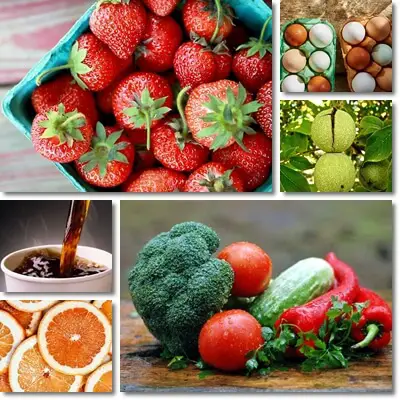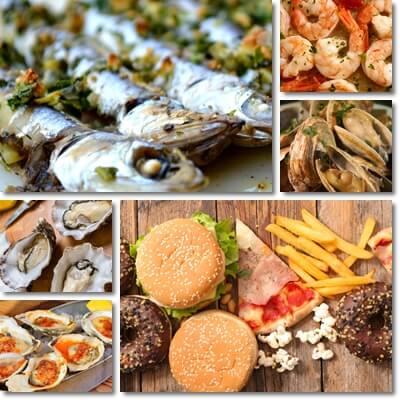Gout is a form of arthritis, an inflammatory condition affecting primarily joints and the tissues around them. It is characterized by swelling, localized redness, burning sensation, pain and other symptoms.
Gout occurs as a result of high levels of uric acid that crystallize over time and form deposits in joints and the tissues around them, resulting in visible inflammation and pain.
For the most part, gout is a genetic form of arthritis. However poor dietary and lifestyle habits are known to both cause and worsen an already existing gout.
Anti-inflammatory foods like cherries and sour cherries and turmeric are good to eat and can help manage and prevent gout attacks, while processed foods, red meats, seafood like shellfish and oily fish are known to increase uric acid and trigger gout episodes.

What is gout?
Gout is one of many forms of arthritis. Like all other forms of arthritis, it targets primarily joints and the tissues around them, producing inflammation that reduces range of movement and restricts mobility. It can affect one or more joints at a time and usually occurs in episodes stretching from a couple of days to almost two weeks. Over half of gout sufferers experience more than one episode in a year. One of the typical symptoms is redness of affected joints, burning sensation, swelling and progressing pain.
Like all other forms of arthritis, gout ultimately causes joint destruction and bone erosion, hence the importance of receiving treatment and managing the condition.
Gout and diet: observations
The fact that more thank half of gout cases are genetic doesn’t mean there is nothing you can do about it. In fact, there is plenty you can do to manage gout and reduce the number of episodes and symptoms severity.
Research reveals a strong association between this form of arthritis and bad dietary and lifestyle habits.
Obesity, prediabetes, diabetes and associated symptoms (hypertension, high cholesterol and hyperglycemia) are risk factors for gout and often a result of poor eating and bad lifestyle habits.
Achieving a healthy weight, reducing abdominal fat in particular, managing hypertension, lowering cholesterol and blood sugar levels can bring major improvements for sufferers and even reduce the frequency and severity of gout attacks.
So what foods to eat and what foods to avoid for gout? The perfect diet for gout is one that considers the following aspects: the purine content of foods, their inflammatory or anti-inflammatory activity as well as nutritional and calorie input of foods.
Thus, the best foods are those that are low in purines, have high anti-inflammatory value and help you achieve and maintain a healthy weight in view of enjoying good blood pressure, cholesterol and blood sugar levels.
The worst foods for gout are those high in purines and other compounds that promote inflammation in the body (like hydrogenated fats, saturated fats, salt, food preservatives, sugars, food additives such as smoke aromas and others). Alcohol and cigarette smoke are also bad for gout.

What are purines?
Purines are chemicals that occur naturally in food. Some foods like red meat, oily fish, shellfish are naturally high in purines, while eggs, dairy and most fruits and vegetables (minus legumes) are generally low in purines.
How are purines relevant for gout?
Too much purines in your diet can actually make gout worse because they are broken down into uric acid. High levels of uric acid in the blood form crystals over time which deposit in and around joints, essentially causing gout.
Best foods to eat for gout
1) Foods low in purines
List of foods low in purines: eggs, milk and dairy products, especially low-fat ones (cheese, yogurt, butter), nuts and seeds if you are not allergic (walnuts, pumpkin seeds, sunflower seeds etc.), cereals (barley, rice, rye, wholegrains and byproducts such as pasta, noodles), fresh fruit (strawberries, blueberries, blackberries, grapes, raspberries, citrus fruit, kiwifruit, apples, bananas, apricots, currants, figs, jujubes, lime, mulberries, cherries, sour cherries, pears, plums, quinces, watermelon, honeydew melon etc.) and vegetables (carrots, cabbage, potatoes, sweet potatoes, tomatoes, cucumber, zucchini, onion, garlic, pepper, parsley, radishes, beets, turnip, parsnip, horseradish, wasabi and others).
2) Natural anti-inflammatory foods
Certain foods exhibit a high anti-inflammatory activity and are reported to help reduce swelling in the body and manage symptoms of various inflammatory conditions, including arthritis. Some of the best anti-inflammatory foods include: cherries, sweet and sour/tart cherries, turmeric, ginger, some Omega-3 rich foods (walnuts, eggs and low fat fish) and foods rich in vitamin C as those listed below.
Cherries, sour cherries and the juice made from them have an excellent anti-inflammatory activity and regular consumption has been reported to reduce swelling and pain associated with arthritis considerably.
See the benefits of cherries and cherry juice for gout.
3) Foods rich in vitamin C
The best food sources of vitamin C include: camu camu, Kakadu plum, acerola cherry, strawberries, bell peppers, kiwifruit, citrus (lemons, oranges, tangerines, limes, grapefruit), rose hip, wolfberry, guava etc.
4) Other foods that are good for gout
There are studies that have found associations between moderate coffee consumption and reduced risk of gout both in men and women. Although the caffeine in coffee is essential a purine, it would appear that coffee drinking can help manage the condition presumably as a result of other beneficial compounds (source: Coffee, tea, and caffeine consumption and serum uric acid level: the third national health and nutrition examination survey).
Observations
However, no food is universally healthy which means that two people with the same medical condition may react differently to the same healthy food that is supposed to be good for both of them simply because they share in the same condition.
But we are all different and what may be good for some people is not necessarily good for everyone. For example, some gout sufferers may find relief in drinking coffee, while others might find that it worsens their symptoms measurably. Both scenarios can be true because coffee has both benefits and side effects (read more about the health benefits of coffee and the side effects of coffee).
The same can be said about other foods too. For example, while bell peppers and citrus fruit are good sources of vitamin C to help reduce swelling in gout, they are also bad for gastritis and cause acid reflux, so they might not be the best choice for someone with both gout and gastritis.

Worst foods to eat for gout
As for foods that are considered bad for gout, some people might experience a worsening of their symptoms if they eat them, while others might find those supposedly bad foods do not upset them too much, when consumed in limited amounts of course. However, it is generally best to avoid certain types of foods altogether and limit intake of others in order to enjoy improvements in your condition. As such, consider the list of foods below to give you a good idea of the main foods to avoid or reduce intake of if you have gout.
1) Foods high in purines
It is recommended to completely avoid intake of high-purine foods during gout attacks and otherwise limit them considerably to manage the condition in the future. Foods high in purine include:
- Organ meats: gizzards, hearts, kidneys, liver, sweetbreads, lungs, spleen.
- Seafood: oysters, mussels, scallops, shrimp, crab, lobster, fish roe and caviar.
- Oily fish: anchovies, sardines, herring, haddock, mackerel, tuna, salmon.
- Meat: game (venison, partridge, pheasant, rabbit), pork, beef, veal, mutton, lamb, goose, turkey.
- Cold meats: bacon, ham, sausage, salami and other cold meats made from those above.
- Other: yeast, sodas, caffeinated beverages, alcohol, high-sugar syrups, pastry, baked goods, sweets.
A lot of foods high in purines are nutritionally dense and full of benefits for health (e.g. see the benefits of liver). However, if you have gout, then the side effects may outweigh the benefits and you may see yourself needing to limit intake considerably, if not exclude certain foods completely, at least for a while. Do consider your individual response to different foods in order to make the best decision for you.
2) Foods containing moderate amounts of purines
Even though their purine content is not high, foods that have moderate amounts of purines should also be consumed in limited amounts if you have gout, and avoided during gout attacks.
- Meat: chicken, duck.
- Legumes: peas, beans, chickpeas, soybeans, lentils.
- Other vegetables: mushrooms, asparagus, spinach, cauliflower.
Again, consider individual reactions to foods and make a decision that benefits you personally.
3) Processed foods
Foods and beverages high in fats, salt, sugar, food additives and preservatives are bad for gout and should be avoided during an episode, and consumed in very limited amounts at all times.
Chocolate and gout
Cocoa and dark chocolate contain high amounts of two purines: caffeine and theobromine. Eating too much of cocoa or dark chocolate can worsen symptoms by raising uric acid levels in the blood and encouraging deposits in joints and the surrounding tissues. At the same time, they are a rich source of antioxidants and it is possible some sufferers may experience benefits after eating cocoa or chocolate.
Observations
When it comes to gout, it is also important to maintain an overall balanced and varied diet that provides you with every nutritional element you need on a daily basis. Avoid smoking, reduce stress factors and take the medication your doctor prescribed. Eating small meals often, drinking plenty of water and practicing moderate physical activity can be beneficial as well. Lastly, learn what foods seem to be good for you and what foods you should avoid in order to best manage your gout.
